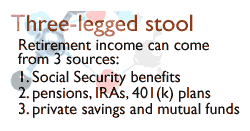|
Social Security report card
|
 |
April 26, 2000: 6:11 a.m. ET
Whether you're 25 or 65, review your annual benefits report when it arrives
By Staff Writer Jennifer Karchmer
|
NEW YORK (CNNfn) - Whether you're a 20-something just settling into your new dot.com job, or you're in your late 50s closing in on your retirement years, you'll want to look in your mailbox for something from Social Security.
That's because the Social Security Administration is beginning a mass mailing to workers 25 and over of a statement outlining their estimated retirement benefits. For some, retirement may be like a far-off land. But by taking out your calculator now and checking that your estimated benefits are correct, you can be that much closer to reaching your retirement goals.
"We'd like to put something in people's hands each year and say, 'Take a look at this. Is it correct?'" said Kurt Czarnowski, regional public affairs officer for the Social Security Administration New England office.
You've got (or you're getting) mail!
You will receive a four-page Social Security statement in your mailbox every year about three months before your birthday. In October 1999, the Social Security Administration began using mailing lists provided by the IRS to send out benefits statements annually to anyone 25 and older who is not already receiving benefits.
 And don't throw out the statement or shove it under miscellaneous paperwork on your desk, Czarnowski urges. Take a few moments now to review it and check for errors. You've earned these benefits and you'll begin receiving them either at retirement or if you become disabled. And don't throw out the statement or shove it under miscellaneous paperwork on your desk, Czarnowski urges. Take a few moments now to review it and check for errors. You've earned these benefits and you'll begin receiving them either at retirement or if you become disabled.
"We don't want to have people wandering into their Social Security office at age 65 with their statement at that time and saying, 'Look, it's not all there,'" Czarnowski said.
You can request your Social Security statement by calling 800-772-1213.
Social Security in black and white
Your Social Security statement will provide an estimate of your benefits, which are based on your highest 35 years of earnings. The report will outline the monthly benefits:
- you are expected to receive at age 62, full retirement age, and age 70
- you are entitled to if you become disabled
- your family could receive should you die.
Let's say Josephine Q. Public, a 40-year-old, who began working in 1980, has an annual salary of $65,000.
 At her current earnings rate, if she stopped working at 62, her monthly Social Security payment would be $1,105. If she retired at 67, which is considered her full retirement age, she would receive $1,580 a month. And if she waited until age 70 to retire, her monthly payment would be about $1,905. At her current earnings rate, if she stopped working at 62, her monthly Social Security payment would be $1,105. If she retired at 67, which is considered her full retirement age, she would receive $1,580 a month. And if she waited until age 70 to retire, her monthly payment would be about $1,905.
Click here to get a rough estimate of your Social Security retirement benefits.
Correct any mistakes
As you peruse your Social Security statement, you might notice that some of the earnings from a part-time job are not included. Or maybe the earnings from your first job out of college just don't add up correctly.
Find your W-2 earnings report for the years in question and call the Social Security Administration at 800-772-1213 to correct any errors.
It's the worker's responsibility to come up with a W-2 form, letter from a past employer, or final pay stub, noting any errors in earnings, says Stephen Richardson, deputy public affairs officer with the Social Security Administration.
The SSA doesn't currently have data showing how often errors occur in benefits statements. The recent push in the annual mailings though is to encourage workers to correct errors as soon as possible, Richardson said.
Three golden years sources
We've all heard that we shouldn't count on Social Security benefits alone for our retirement income. In fact, financial experts such as Diane Rolfsmeyer, a certified financial planner (CFP) in Lincoln, Neb., say your income during your golden years should come from three sources:
1. Social Security
2. IRAs and employer-sponsored plans, such as pensions or 401(k)s
3. Private savings, like mutual funds, stocks and other investments.
But maybe you're like many younger workers who are skeptical about Social Security even being around when you retire in 40 years.
Czarnowski and others point out that Social Security is more than just a retirement program. You are eligible to receive benefits today should you become disabled on the job. And your family would receive your survivor benefits should you die. So even if retirement seems light years away, the statement detailing your benefits can be useful.

"It's an informational tool like any other investment or savings document," Rolfsmeyer said. "I am thrilled that the Social Security Administration is (mailing out statements annually)."
So now that you have an estimate of how much your Social Security benefits will be, you can use an online retirement planner to map out your long-term savings plan.
Click here for the Social Security Administration's new retirement planner!
"Whether you're 25, 35, 45 or 55, it's never too early to plan for your future retirement," said Social Security Commissioner Kenneth S. Apfel. 
-- Click here to send comments about this story to Staff Writer Jennifer Karchmer.
|
|
|
|
|
 |

|

